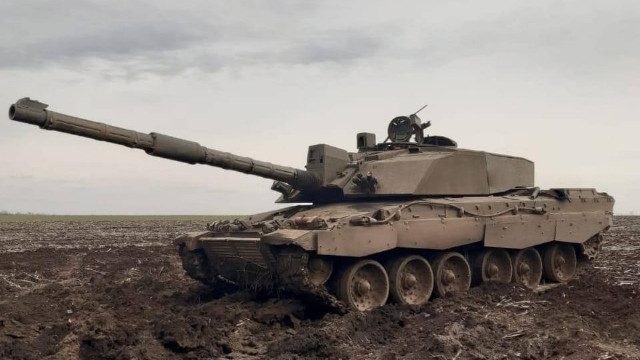 Photo: Telegram
Photo: Telegram
Following a dramatic reduction in the deployment of the initial Challenger 2 tank on the Ukrainian front over the last three months of 2023, the Ukrainian armed forces seemed to have almost completely ceased utilizing these British tanks. There was even a two-month stretch without a single report of their usage making the news, The Bulgarian Military notes.
Despite recent military briefings confirming the destruction of at least three Abrams tanks – and possibly four – we now witness the first instances of the Challenger tank resurfacing on the battlefield. The images shared today do not disclose a timeframe or location, thus sparking speculation that the actual reappearance of the Challenger 2 might not even be taking place this month.
Those seeking to pinpoint the timing of the Challenger’s resurgence through photos disseminated via Telegram are stumped. While the tank’s surroundings suggest winter-to-spring conditions, there are no telltale signs of snow or emerging vegetation. The only clue is the dug-up soil, which holds a strong resemblance to Ukraine’s characteristic chernozem soil.
What’s particularly notable is the absence of any tank enhancements. It’s quite the norm to spot Leopards, Challengers, Abrams, and Soviet tanks in Ukraine, each accessorized with supplementary installations. Whether these are dynamic armor or the much-talked-about cage copes, this specific Chelindajr 2 lacks either.
Cast your mind back to August of the previous year when the first Challenger 2 made an appearance on Ukrainian soil, donning a cage cope mounted on its dome. These enhancements didn’t stop there. Both sides and the front of the tank were shielded with standard protective bars, a measure designed to lessen the impact from anti-tank missiles, kamikaze drones, or FPV drones.
The secretive nature of warfare means that any weapon system supplied to Ukraine from Western countries becomes valuable information for Russian forces.
While leveraging Western strategies on the battleground might not equate to “earning bonus points at the grocery store,” it’s important to note that Russian forces receive ample compensation for their efforts. The Russian defense ministry has set a price on the destruction of enemy equipment, offering soldiers 100,000 rubles [approximately $1,200] for taking out an enemy tank and 50,000 rubles [roughly $600] for rendering an armored vehicle inoperative. However, these incentives do not extend to the damage to Soviet equipment currently in use by Ukraine’s armed forces.
In the eyes of Russian observers, the initial “Challenger 2 tank squadron” is forecasted to quickly deteriorate in the challenging terrain of Ukraine. With the speculation that the 14 Challenger 2 tanks are only the beginning of numerous deliveries, the Russians anticipate additional shipments. Their hypothesizing further emphasizes that London is proactively reducing its surplus weapons systems.
read more in our Telegram-channel https://t.me/The_International_Affairs

 11:24 19.03.2024 •
11:24 19.03.2024 •






















